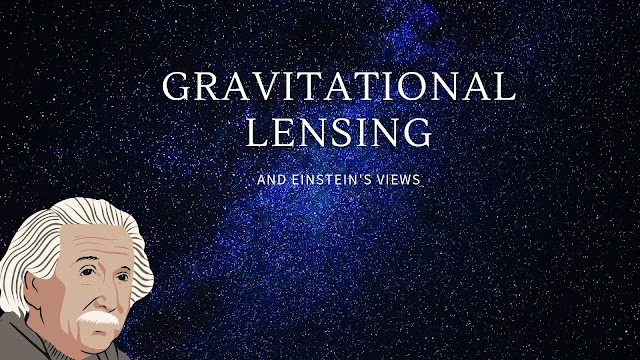Gravitational Lensing: An Overview
Introduction:
When a massive volume of matter, such as a cluster of galaxies, forms a gravitational field that bends and magnifies light from distant galaxies that are behind it but in the same line of sight, this is known as a gravitational lens.
Only the greatest telescopes can view the related phenomena of gravitational lensing, which is only apparent in rare situations.
Einstein's view on Gravitational Lensing:
Einstein set down a succinct statement of one of the most fundamental consequences of light deflection as early as 1912, a good three years before his eventual breakthrough in the formulation of general relativity: A (geometric) gravitational lens could be possible. Einstein hypothesized in the 1930s that mass distribution, such as a galaxy, may function as a gravitational "lens," distorting images of objects beyond the gravitating mass as well as bending light. While Einstein's theory of gravity has passed every test to date, no one can be certain that it holds true everywhere and under all circumstances. There's no certainty, for example, that general relativity will apply to the entire galaxy. And, just in case it doesn't, various competing ideas have been suggested over the years.
Massive objects, such as stars, could bend light rays passing close, according to Albert Einstein's General Theory of Relativity, published in 1916. The observation of such bending of starlight near the Sun in 1919 confirmed this hypothesis. In the same year, Sir Oliver Lodge, an English physicist, proposed that this phenomenon may generate a gravitational lens. Einstein demonstrated in 1936 that if a brilliantly illuminating object is placed directly behind a big body capable of producing a gravitational lens, the outcome is an image of a ring around the massive lensing object. However, he ruled out the prospect of ever finding such a lens due to the slim likelihood that the exact coincidence required would ever occur.
The curvature of space-time is referred to as gravity. Einstein joined the dots here, implying that gravity is caused by the distortion of space and time. Gravity is the curvature of the cosmos generated by big masses, and it governs how objects move. That curvature is dynamic, meaning it changes with the motion of the objects.
Gravitational lensing can increase the light of a background galaxy as well as distort it. Hubble can view fainter and further galaxies via a lensing galaxy cluster than he could otherwise. It's as if you had an additional lens the size of a galaxy cluster. A solar eclipse observed in 1919 proved Einstein's prediction that light bends in the presence of mass. This experimental confirmation of Einstein's general theory of relativity brought him instant international fame.
The gravitational hypothesis is also known as the Einstein Ring in honour of Einstein.
When light from a galaxy or star travels through a huge object enrooted to the Earth, it forms an Einstein ring, also known as an Einstein–Chwolson ring or a Chwolson ring (named after Orest Khvolson). The light is redirected due to gravitational lensing, making it appear to come from multiple places.
The images of gravitationally lensed light sources are commonly curved into an Einstein ring, but because the lensing galaxy is elongated and the quasar is off-centre, they form a strange cross-shaped instead.
The first Einstein ring was discovered by Hewitt et al. (1988), who used the Very Large Array to examine the radio source MG1131+0456. A quasar was lensed into two different but highly similar views of the same object by a nearby galaxy, the images stretching around the lens into an almost full ring.
They discovered 19 new gravitationally lensed galaxies, including eight with Einstein rings. Einstein rings are a sort of gravitational lensing that Einstein's general theory of relativity predicted would happen. The gravitational pull of a complete galaxy may bend and twist light in unexpected ways.
What does Gravitational Lensing do?
Gravitational lensing allows studies of the distant universe and explores the distribution of matter in galaxies and clusters of galaxies. Hubble's data will also serve as a foundation and guidance for the James Webb Space Telescope, whose infrared observations will push the frontiers of space exploration even further. The gravitational pull of big objects in the universe can twist or bend light generated by distant galaxies as it passes by them. Gravitational lensing is the term for this phenomenon.
Observing how the gravity of giant galaxy clusters, which include dark matter, bends and distorts the light of more distant galaxies lying behind the cluster, astronomers can discover dark matter's influence. Gravitational lensing is the name for this phenomenon. The Hubble Space Telescope captured this image of a faraway galaxy in the constellation Fornax. It is one of the largest and most complete Einstein rings ever found. Gravitational lensing is responsible for this object's unique shape. (Its official call sign is SBS 0957+561.) Dennis Walsh, Bob Carswell, and Ray Weymann found this gravitational lens for the first time using the Kitt Peak National Observatory's 2.1-meter telescope. The Einstein radius is the circumference of an Einstein ring, and it is a characteristic angle for gravitational lensing in general because typical distances between pictures in gravitational lensing are on the order of the Einstein radius.





Well explained
ReplyDelete